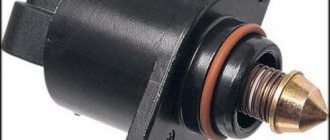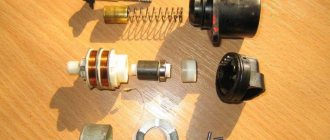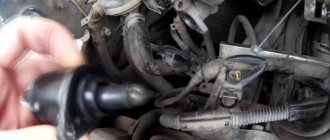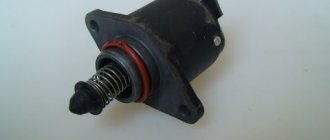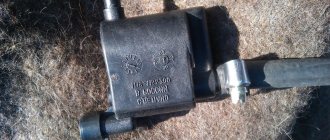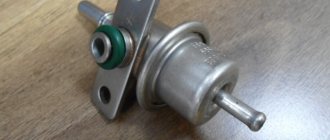The injection engine, unlike outdated carburetor analogues, operates under the control of an electronic-mechanical system. In this case, the electronic components are the main ones, forming the electronic engine control system (ECM).
Simply put, the electronic engine management system is actually a set of sensors that transmit their readings to the ECU. In turn, the controller records the received data, after which it generates control signals and sends commands to the actuators.
In this case, the list of main sensors includes: crankshaft sensor, camshaft sensor, temperature sensor, throttle position sensor, as well as mass air flow sensor and idle air control sensor (IAC sensor). Next, we will look at where the idle speed sensor is located, what are the signs of its malfunction, and how to check the idle speed sensor.
Types and designs of IAC
The appearance of the sensor resembles an electric motor with a conical needle. The device is responsible for supplying the required amount of air bypassing the throttle valve at idle.
There are several types of such sensors:
- Solenoid based. This is the simplest version of the device. When voltage is applied to the windings of the device, the core is triggered and placed in a special socket to reduce the diameter of the passage channel. As a result, the air supply volume becomes smaller. This regulator is inexpensive due to its simplicity of design. This device only works in the closed or open position.
- Stepper. It includes windings and a ring magnet. The rotation of the main rotor occurs due to the stepwise supply of voltage to all structural elements under the influence of electromagnetic force. The opening of the air duct is controlled by an actuator depending on where the rotor is located.
- Rotary. The air supply is regulated by alternating frequency pulses. The sensor design is similar to the PXX solenoid. The main role in the design is played by the rotor.
Reasons for high speed on the injector
On the injector, the reasons why the speed increases can be divided into:
- related to electronic malfunctions;
- associated with mechanical problems.
In the first case, the sensors or controllers are acting up. In case of malfunctions of this kind, it is best to seek the help of specialists.
Throttle valve
If the reason lies in the poor functioning of the throttle valve (in most cases, it becomes jammed), the following happens:
- the volume of air entering the cylinders increases disproportionately;
- The ECU will "demand" more fuel to balance the mixture.
As a result, the car will not only consume much more fuel than it should, but it may even fail due to constant “overload” at high idle speeds. Diagnostics of the damper and, depending on the diagnostic results, chemical cleaning or replacement will help resolve the problem.
Engine temperature sensor
This device is considered subject to frequent failures, since it is located in the epicenter of inevitable temperature changes. If it was noticed that with certain initial conditions everything is in order with the motor, but the sensor is “playing naughty”. To diagnose, you will have to delve into the wiring.
With the ignition on you need to:
- take data on the resistance from contact “A” to ground (the exact correct value is 10 Ohm);
- take data on the resistance from ground to terminal “B” (if less than 10 Ohms, you need to sound the alarm;
- also take data on the voltage at terminal “B” in relation to ground (the exact correct value is 5V).
There may be a problem with the sensor itself. To determine this, you need to take the above resistance readings with the engine cooled down and warmed up. When working properly, the readings should not differ.
Engine temperature sensor
Air flow sensor
The oil film that envelops this device during vehicle operation eventually leads to malfunctions of the element that measures and sends a signal to the computer about the amount of incoming air (hot-wire anemometer). As a result, the ECU does not have access to reliable information about the amount of air, and the speed begins to float. But first of all, it is worth inspecting the air filter. Perhaps it is simply clogged and air is not flowing freely.
Intake manifold
High speeds may be associated with air suction. There can be two types of faults in this unit:
- deformation of the intake manifold;
- breakdowns or burnout of the gasket.
If the second case is not so catastrophic, then the first will most likely lead to a call to the services of a car service, since grinding may be required. Problems will be detected, including when the engine warms up.
Other reasons
Other common reasons may be the following:
- jamming of the gas pedal, which is typical for both an injector engine and a carburetor engine;
- On the injector, the IAC (idle air control) and TPS (throttle position) sensors may fail: if there is a suspicion that it is they who are “sinning,” you will need to check the contacts;
- ECU failures, which are checked using special computer programs;
- the generator does not supply the required current rate, so the motor will begin to accelerate in pursuit of the required voltage;
- For cars with a turbocharger, high speeds at idle can be caused by its wear or depressurization of the rotor shaft gasket.
If you cannot confidently identify the cause of the increase in speed, it is more prudent to contact specialists (especially in the case of an injector).
Intake manifold with throttle valve
How the regulator works
When the engine is idling, through an additional air supply channel, bypassing the closed throttle valve, the air necessary for its stable operation enters the engine. The cross section of this channel is regulated by IAC. The amount of air is taken into account by the mass air flow sensor (MAF). In accordance with its quantity, the controller supplies fuel to the engine through the fuel injectors.
Using the crankshaft position sensor (CPS), the controller monitors the number of engine revolutions. Depending on the set mode, the IAC operates, adding or reducing the air supply bypassing the closed throttle valve.
When the engine is warmed up to operating temperature, the controller maintains idle speed. If the engine is not warmed up, the controller increases the speed using the regulator, ensuring it warms up at higher speeds.
Idle adjustment
It is recommended to start adjusting the idle speed only when the previous adjustment step has already been completed. To configure this parameter you need to:
- Tighten the quality screw counterclockwise until it stops. This part is located in the hole in the carburetor sole.
- Screw the quality screw six turns to the right.
- Start the engine and remove all gasoline leaks.
- Find the quantity screw and use it to set the minimum speed for the engine. It is best if the mechanism operates at 900-1200 rpm.
- Slowly and carefully tighten the quality screw until the motor begins to operate in an unstable mode. After this, it is necessary to restore stable operation by tightening the screw in the opposite direction one to one and a half turns.
- By rotating the quantity control screw, set the idle speed to 850-900 rpm; if necessary, you can tighten the quality screw.
Adjustment of different types of carburetor is carried out according to the same scheme
Problems with setting the idle speed can arise due to a defective nozzle, a “third-party” leak of gasoline, for example, when the solenoid valve or plug is not tightly closed, or an incorrectly sized nozzle.
It is worth noting that this mechanism is not recommended for engines with a volume of more than one and a half liters, as this can lead to engine malfunction at high speeds. Also, to increase the power of the base carburetor, it is best to replace the original jets.
And one more important point - carburetor adjustments must be made only when the engine is warm.
Adjustment of many types of carburetors is carried out approximately according to the same principles. Depending on the manufacturer, a similar scheme may also be relevant for adjusting this mechanism on a scooter, and can also be used for a motorcycle. But if the vehicle is under warranty, it is not recommended to adjust the carburetor yourself. In this case, if it is necessary to exercise the right to warranty repairs at the official service center of the manufacturer, specialists may refuse to provide these services. This almost does not apply to domestic vehicles, but on most foreign cars the factory equipment must be maintained until the end of the warranty period, then the car owner can, if necessary, calmly contact the service center.
Thus, adjusting the carburetor of a VAZ 2105, 2106 and others is quite simple; for this it is not necessary to contact specialists; you can configure this mechanism yourself.
Symptoms of a problem
The idle air control is an actuator and its self-diagnosis is not provided for in the system. Therefore, when there is a malfunction of the idle air control, the “CHECK ENGINE” lamp often does not light up. Symptoms of malfunctions of the idle speed controller are in many ways similar to malfunctions of the TPS (throttle position sensor), but in the second case, most often the “CHECK ENGINE” lamp clearly indicates a malfunction of the TPS.
Symptoms of problems with IAC:
- floating idle;
- poor engine starting, especially in winter;
- the car may stall when releasing the gas after switching to neutral;
- uncontrolled increase or decrease in idle speed at normal engine temperature;
- drop in speed after turning on the headlights, air conditioning, heating system;
- jerking of the car while driving at low speeds;
- The engine stalls when changing from low to high gear and vice versa.
The above symptoms may appear all at once or separately.
Sensor diagnostics
You can check the idle air valve yourself. Its faults can be divided into two parts: mechanical and electrical. There are several verification methods.
Visual inspection
First you need to conduct a visual inspection. In this way, you can detect body defects, needle wear, and carbon deposits. If deposits form, you can clean them with carburetor cleaner. It is also recommended to clean the entire throttle body as it is in a similar condition.
Using diagnostic programs
The operation of the IAC can be checked using a diagnostic adapter and special programs. For example, you can use the simplest ELM327 adapter and the OpenDiagMobile program. In the program menu you need to select the desired position of the XX regulator and watch the operation of the valve. It is better to set it at least 20 steps more than the current position.
Wiring check
For this we need a multimeter. With the engine off, remove the connector from the sensor. We set the measurement limit on the measuring device to 0-20 V DC voltage. We measure the voltage at the connector. Normally it should be 12V.
Checking the regulator resistance
To do this, we will need to measure the resistance between terminals A, B, and C and D after disconnecting the sensor terminal. We move the multimeter to the position of measuring resistance at the limit of 0-200 Ohms (Ω).
The normal value is within 50-55 Ohms. The resistance between A and C, B and D must be infinity.
Checking with throttle assembly
There is another way to diagnose IAC. To do this, you will need to remove the throttle assembly from the studs along with the sensor.
By connecting the valve connector and turning the ignition on/off, you can observe the operation of the IAC live. See how the needle works, if it is rubbing somewhere, check the evenness of the stroke, hear suspicious sounds.
VAZ 2107 increased idle speed
The VAZ 2107 idle speed control is removed to replace it with a new one if the old one fails as a result of any mechanical damage. Before removing the regulator, it is recommended to test it with a performance tester; the test comes down to simply measuring the voltage at the terminals of the block, and after removing it, measuring the resistance at the same terminals. To check, you will need a multimeter with voltmeter and ohmmeter mode, as well as a standard set of tools.
The procedure for checking and subsequently replacing the idle air regulator is as follows:
- Connect the negative terminal of the voltmeter to engine ground and turn on the ignition on the car.
- Disconnect the block from the regulator; the terminals will be marked on its body.
Connect the positive terminal of the Vols and then to the “D” terminal. The voltage at the terminals should be 12V. For any significant deviations from the norm of more than one volt or a complete absence of voltage, the cause may be either a weak battery charge, faulty power wiring or a malfunction. After measuring, turn off the ignition.
If the voltage at the terminals is normal, but the regulator does not perform its direct functions, then it must be changed. Removing and replacing the regulator looks like this:
- It is necessary to remove the throttle body, see for more details.
- After that, use a Phillips screwdriver to unscrew the two screws securing the regulator to the damper body and remove it.
- A rubber sealing washer will be installed between the regulator and the housing. Replace it if cracks or other damage is found.
After it is removed from the car, it must also be tested with a tester in ohmmeter mode. For this:
- Switch the tester to ohmmeter mode and measure the resistance between terminals A-B and C-D, it should be about 52-53 Ohms. Next, measure the resistance between terminals A-C and B-D, the resistance should tend to infinity or be large enough. If there are any deviations from the norm, replace the regulator.
This completes the repair work. Install the new regulator in the reverse order of removal. Before installing the regulator, measure the length of the valve needle protrusion; it should not protrude more than 23mm. To measure, use a caliper or any suitable ruler. Before measuring, it is necessary to extend the needle to the maximum distance; to do this, apply voltage from the battery to the valve, connecting the positive pole to terminal “D” and the negative pole to “C”. The regulator solenoid valve works slowly, so touch the wires repeatedly until the needle reaches its maximum length. Measure with a ruler and if the needle protrudes more than 23mm, replace the valve.
Idle speed regulator VAZ-2104, VAZ 2105, VAZ 2107
Idle speed regulator VAZ-2104, VAZ 2105, VAZ 2107
The sequence of work to check the idle air control on a VAZ-2104, VAZ 2105, VAZ 2107 car
1. Release the clamp of the wiring harness block and disconnect the block from the idle speed control.
The terminals are marked on the idle air control block.
2. Connect the negative probe of the engine voltage.
3. Having turned on the ignition on the VAZ car, use a voltmeter to measure the voltage at terminals A and D of the idle speed control block.
ATTENTION The voltage on the idle speed regulator block must be at least 12 V (the negative probe of the device must be connected to the engine ground). If the voltage does not reach the idle speed control block or it is less than 12 V, the battery is discharged, the power circuit is faulty or the ECU is faulty.. 4
After completing the voltage measurement, turn off the ignition on the VAZ-2104, VAZ 2105, VAZ 2107.
4. After completing the voltage measurement, turn off the ignition on the VAZ-2104, VAZ 2105, VAZ 2107.
Removing the idle speed regulator from a VAZ-2104, VAZ 2105, VAZ 2107 car
1. Remove the throttle body.
2. Using a Phillips screwdriver, unscrew the two screws securing the idle air control to the throttle body.
3. Remove the idle speed control. An O-ring is installed in the connection between the VAZ idle speed control and the throttle body. Replace a ring that has lost elasticity or is cracked.
4.
Calibrating a new IAC
What should I do if the test reveals that the sensor needs to be replaced? It needs to be calibrated.
- We check the distance from the end of the rod to the mounting plate, it should be no more than 23mm.
- We disconnect the minus from the battery, de-energizing the ECU.
- Install the regulator.
- We connect the battery back.
- Turn on the ignition for 5 seconds without starting the engine. At this time, the IAC calibration occurs.
- Turn off the ignition to complete the calibration.
- We start the engine and observe the idle speed.
Now you know how the idle air regulator works, how to check it and, if necessary, replace it. As you understand, there is nothing complicated about this and all operations are accessible even to a novice car enthusiast.
Finally, a video about diagnosing IAC:
Previous post How to check gasoline injectors
Next entry Misfires - causes, diagnosis, elimination
Replacement
Replacement is quick and easy, just follow the instructions below.
- We remove the negative mark from the battery, since the work is carried out on the electrical equipment of the car
- Remove the connector from the regulator and unscrew the two screws using a Phillips screwdriver
- We take out the regulator and install a new one in the reverse order. Don't forget to install an O-ring between the IAC and remote control. It is recommended to lightly lubricate the ring with engine oil for easier installation into the throttle body.
We hope our article was useful to you.

